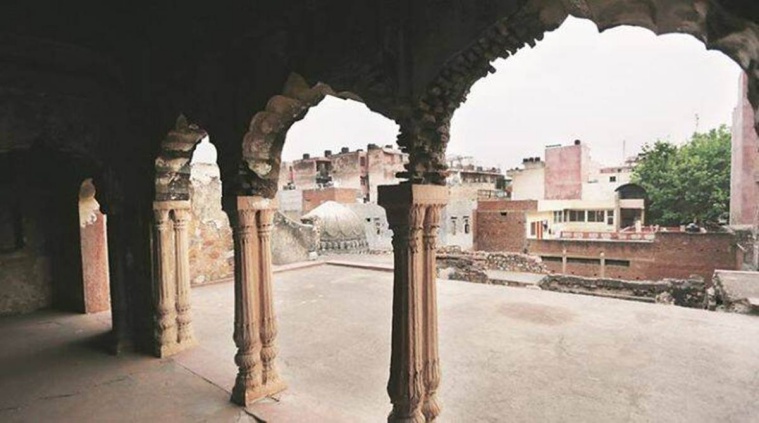Stay updated with the latest - Click here to follow us on Instagram
Zafar Mahal, last palace built by Mughals, lies in wait of repair, restoration
The last palace built by the Mughals, the huge red sandstone gate impresses from a distance.
 The Zafar Mahal in Mehrauli, New Delhi. (Express Photo/Arnav Chandrashekhar)
The Zafar Mahal in Mehrauli, New Delhi. (Express Photo/Arnav Chandrashekhar)On the anniversary of the 1857 Siege of Delhi on June 8, few will remember the Mughals who saw their reign end.
The Zafar Mahal in Mehrauli is a monument that reflects this aptly. The last palace built by the Mughals, the huge red sandstone gate impresses from a distance.
But on closer look, mounds of garbage are strewn around the parking lot. Within the palace, walls and pillars crumble and seem to be at the point of collapse. The graves of three Mughal emperors are somewhere within the decaying Mahal. Before he was exiled to Rangoon by the British, Bahadur Shah Zafar wished to be buried here beside his forefathers. His grave lies empty.
“The Zafar Mahal is in a really sad condition, especially when you consider how important it is to the history of Delhi. Once the Mughal court used to move there in the summers, and observe the Phool Walon ki Sair (procession of florists). But now, locals play cricket inside. I’ve even seen people drinking alcohol and gambling within the Mahal. The one guard posted here by the Archaeological Society of India can’t deal with all this by himself,” says historian Rana Safvi.
 Before he was exiled to Rangoon by the British, Bahadur Shah Zafar wished to be buried here beside his forefathers. (Express Photo by Tashi Tobgyal)
Before he was exiled to Rangoon by the British, Bahadur Shah Zafar wished to be buried here beside his forefathers. (Express Photo by Tashi Tobgyal)
Filmmaker and historian Sohail Hashmi agrees: “In 1920, it was recorded that there were 3,000 historical sites in Delhi. When the ASI audited this list in 2010, 2,000 of these sites had ceased to exist. The Zafar Mahal is not alone in its condition – even protected monuments are not always safe in the national capital. This problem is particularly bad in the Mehrauli area. The few security guards employed by the ASI can’t be everywhere at once.”
However, Safvi notes, “The ASI has a role to play in keeping monuments of Delhi in good condition, but the public has a responsibility as well. If the residents of Delhi don’t realise its value and historical importance, that’s just as big a problem.”
ASI officials have stated that they are aware of the condition of the Zafar Mahal, and that a restoration plan had been put on hold by Covid-19. They say that funds are ready, and plans to restore it are moving forward now. Officials have also stated that encroachment by locals has also been an issue, and appropriate action will be taken.
In other places, it isn’t time or negligence that has eroded the legacy of the Mughals. The exact burial place of Zafar’s two sons and a grandson, who were executed by the British, is still unknown. One of the sons being Mirza Mughal, who commanded the defence of Delhi alongside sepoy general Bakht Khan.
According to Hashmi, “The British led the Mughal princes to the Lal Darwaza, which is now known as the Khooni Darwaza (Bloody Gate). They were killed by the Englishman Captain Hodson, who was then promoted.”
Safvi said, “Sources from 1919 mention that the executed princes were buried in the Baqi Billah Naqshbandi Dargah. But the exact location is not known, as the British would have taken pains to ensure that they did not become a symbol for future revolts.”
Although one figure from this era has received the legacy he is due. Mirza Ghalib, the poet laureate of the Mughal court, is buried in a marble tomb near the Nizamuddin Dargah. He is in good company – a foster brother of Akbar himself is buried within the nearby Chausath Khamba. The local ASI guard, Sunil, greets visitors with appropriate gravitas, inviting them to see Ghalib saheb.
“He deserves the pride of place there. Along with Khusrau, he was one of the greatest Urdu poets,” says Hashmi.
Carved next to his tomb is an uncharacteristically humble Urdu poem that ends with the line, “Dubaya mujhko hone ne, na hota main to kya hota? (My being has defeated me. Had I not been, what would have been?)”
This part of Delhi’s history, at least, lives on.






